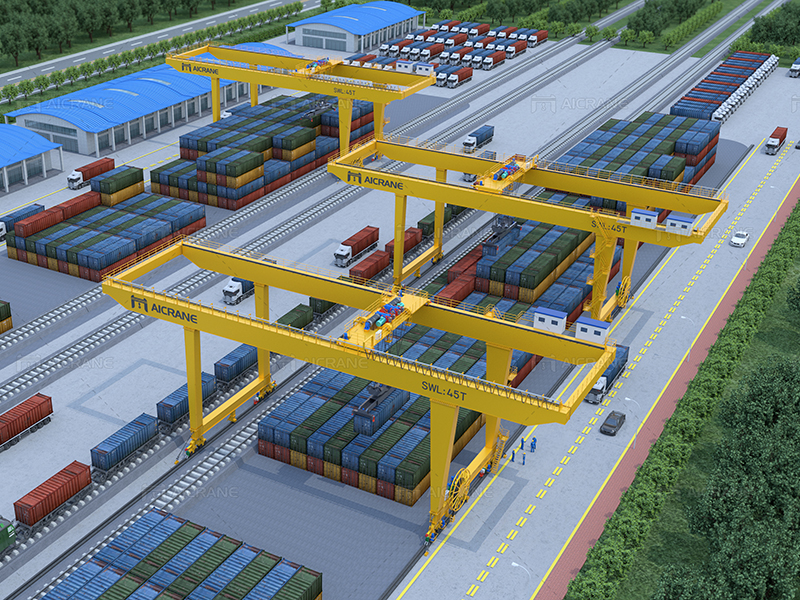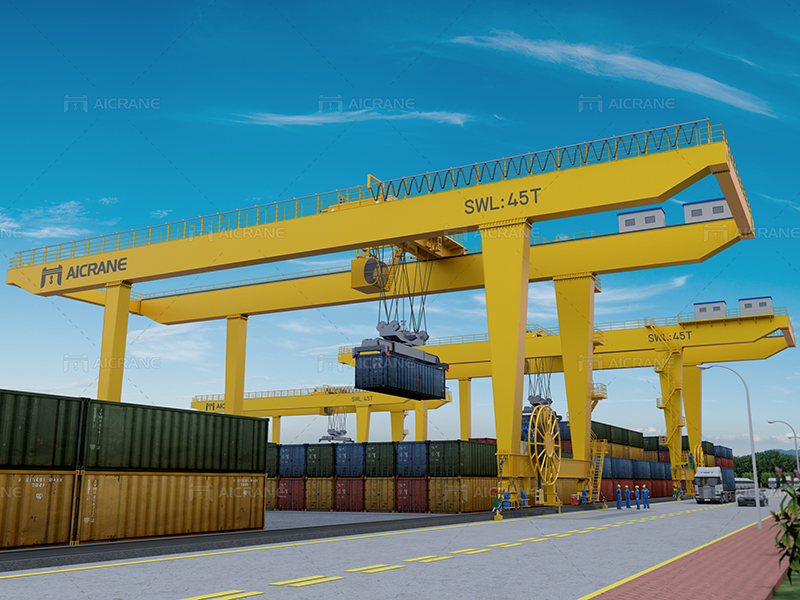In the dynamic world of global trade, efficient container handling is a cornerstone of successful port operations. Rail-Mounted Gantry Cranes (RMGs) have emerged as indispensable assets in container terminals, revolutionizing the way containers are stacked, retrieved, and transferred. This article explores the numerous advantages that make RMGs the preferred choice for container handling in modern ports and terminals.

High Stacking Density:
One of the primary advantages of rail mounted gantry cranes lies in their ability to achieve high stacking density. The design of these cranes allows for precise and tightly packed container storage, optimizing the use of available space in container yards. This is particularly crucial in busy terminals where land is often at a premium, and maximizing storage capacity is essential for economic viability.
Efficient Container Handling:
RMGs are engineered for efficiency in container handling operations. Their rail-mounted design enables seamless horizontal movement along designated tracks, allowing them to traverse the entire length of the terminal. This translates to quicker and more precise container retrieval and stacking, contributing to faster turnaround times for vessels and improved overall terminal productivity.
Flexibility in Container Size and Weight:
Container terminals deal with a diverse range of container sizes and weights. RMGs are designed to handle this diversity effectively, accommodating containers ranging from 20 to 40 feet in length and varying weight capacities. The flexibility to handle different container specifications makes RMGs versatile assets in terminals with a mix of container types.
Customization for Terminal-Specific Needs:
RMGs can be customized to meet the specific requirements of individual terminals. Terminal operators can work closely with manufacturers to tailor RMGs to their unique needs, accounting for factors such as stacking height, aisle width, and the type of containers predominantly handled. This customization ensures that the RMGs seamlessly integrate into the terminal’s operations.
Reduced Labor Dependency:
Automation is a key feature of modern RMGs, reducing dependency on manual labor for routine container handling tasks. Automated RMGs can operate continuously, 24/7, without the need for breaks or shift changes. This not only improves efficiency but also minimizes the risk of human error in critical operations.

Enhanced Safety Features:
Safety is paramount in port operations, and RMGs are equipped with advanced safety features. Anti-collision systems, safety interlocks, and emergency stop mechanisms contribute to creating a secure working environment. These features not only protect the equipment and containers but also safeguard the personnel working in the vicinity of the container handling gantry cranes.
Remote Operation and Monitoring:
RMGs are often operated and monitored from centralized control rooms. This remote operation capability provides operators with a comprehensive view of the entire terminal, allowing for precise control and coordination of container handling activities. Real-time monitoring facilitates quick responses to any operational challenges, ensuring smooth and uninterrupted operations.
Energy Efficiency:
Electrically powered RMGs contribute to environmental sustainability by reducing emissions and energy consumption compared to diesel-powered alternatives. Energy-efficient systems, regenerative braking, and the ability to operate on electricity from renewable sources make RMGs a greener option for container handling.
Predictive Maintenance for Reliability:
Modern RMGs often come equipped with predictive maintenance systems. These systems use data analytics and sensor technology to monitor the condition of critical components. By predicting potential issues before they escalate, terminal operators can schedule maintenance proactively, minimizing downtime and ensuring the reliability of the equipment.
Integration with Terminal Operating Systems:
RMGs can be seamlessly integrated with Terminal Operating Systems (TOS). This integration allows for coordinated container handling processes, optimizing the flow of containers within the terminal. Real-time data exchange between RMGs and the TOS enhances visibility, control, and decision-making capabilities.
Cost-Effective Long-Term Investment:
While the initial investment in RMGs may be substantial, their long-term cost-effectiveness is a key advantage. Their durability, reliability, and low maintenance requirements contribute to a favorable Total Cost of Ownership (TCO) over the lifespan of the equipment.
Adaptability to Future Technological Advances:
RMGs are designed to adapt to future technological advances. With the rapid evolution of automation, data analytics, and artificial intelligence, gantry cranes can be retrofitted with new technologies to stay at the forefront of industry innovation. This adaptability ensures that terminals can leverage the benefits of emerging technologies without significant infrastructure changes.
Conclusion:
Rail-Mounted Gantry Cranes have become indispensable in the realm of container handling, offering a myriad of advantages that enhance efficiency, safety, and sustainability in port operations. From high stacking density and efficient container handling to customization, reduced labor dependency, and integration with advanced technologies, RMGs are key contributors to the success of modern container terminals. As the global trade landscape continues to evolve, the role of RMGs in shaping the future of container handling remains pivotal, promising even greater advancements in efficiency and sustainability.